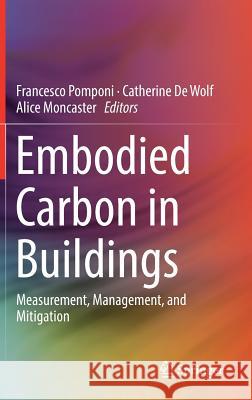Embodied Carbon in Buildings: Measurement, Management, and Mitigation » książka



Embodied Carbon in Buildings: Measurement, Management, and Mitigation
ISBN-13: 9783319727950 / Angielski / Twarda / 2018 / 512 str.
Embodied Carbon in Buildings: Measurement, Management, and Mitigation
ISBN-13: 9783319727950 / Angielski / Twarda / 2018 / 512 str.
(netto: 883,85 VAT: 5%)
Najniższa cena z 30 dni: 848,19
ok. 22 dni roboczych
Bez gwarancji dostawy przed świętami
Darmowa dostawa!
This book provides a single-source reference for whole life embodied impacts of buildings. The book is divided into four sections: measurement, including a strong emphasis on uncertainty analysis, as well as offering practical case studies of individual buildings and a comparison of materials;
"This book is to be welcomed because it brings together a wealth of new knowledge and makes a compelling case for the inclusion of embodied carbon into our thought processes, calculations, practices and governance. It is essential reading and highly recommended to anyone who is serious about reducing the carbon footprint of buildings." (Antonin Lupisek, Buildings & Cities, March 30, 2020)
Dr Francesco Pomponi is the Vice Chancellor’s Research Fellow at the Institute for Sustainable Construction of Edinburgh Napier University. Francesco’s expertise lies with life cycle assessment, embodied carbon, and circular economy and he moved to academia after six years in industry as an engineer and project manager. He is part of the newly launched Annex 72 of the International Energy Agency and has recently chaired the ‘Life Cycle Assessment and Carbon Accounting’ Forum of the International Passive and Low Energy Architecture conference and the ‘Design for Sustainability’ Track of the International Sustainable Development Research Society conference. He is a Fellow of the RSA, a member of the IET, and an Associate Fellow of the HEA. An associate member of St Edmund's College University of Cambridge and of Cambridge Architectural Research (CAR), Francesco regularly collaborates with practitioners and researchers from South and Central America, South Africa, Europe, and of course the UK.
Dr Catherine De Wolf is a Postdoctoral Fellow at the Swiss Federal Institute of Technology in Lausanne (Ecole Polytechnique Fédérale de Lausanne, EPFL) cofounded by the Marie Sklodowska-Curie Postdoctoral Fellowships from the European Commission and a Swiss Government Excellence Scholarship, where she works on low carbon structural design within the Structural Xploration Lab. She also worked as a researcher at the University of Cambridge while obtaining her PhD in Building Technology at the Massachusetts Institute of Technology (MIT), after studying both civil engineering and architecture at the Vrije Universiteit Brussel and Université Libre de Bruxelles. She closely collaborated with leading engineering firms including Arup, Ney & Partners, and Thornton Tomasetti on embodied carbon assessment in buildings. This led to her nomination on the board of the Carbon Leadership Forum and the launch of the Structural Engineers 2050 Commitment Initiative.
Dr Alice Moncaster is a Senior Lecturer in Engineering at the Open University. She remains a Visiting Fellow at the University of Cambridge, where she was previously a Lecturer in Engineering and Director of the IDBE masters course, and a Fellow of Newnham College. The move to academia followed ten years in industry as a civil/structural engineer, during which time she became increasingly concerned about the responsibility of the construction sector for climate change. Alice’s research focuses on reducing the ecological impacts of the built environment. She led the research group Cambridge University Built Environment Sustainability (CUBES) as part of the Centre for Sustainable Development at Cambridge between 2010-17, and has been the UK participating expert on the International Energy Agency Annex 57, and now Annex 72, since 2012.
This book provides a single-source reference for whole life embodied impacts of buildings. The comprehensive and persuasive text, written by over 50 invited experts from across the world, offers an indispensable resource both to newcomers and to established practitioners in the field. Ultimately it provides a persuasive argument as to why embodied impacts are an essential aspect of sustainable built environments.
The book is divided into four sections: measurement, including a strong emphasis on uncertainty analysis, as well as offering practical case studies of individual buildings and a comparison of materials; management, focusing in particular on the perspective of designers and contractors; mitigation, which identifies some specific design strategies as well as challenges; and finally global approaches, six chapters which describe in authoritative detail the ways in which the different regions of the world are tackling the issue.
- Provides a comprehensive, up-to-date guide to embodied carbon calculation and reduction, with a particular focus on understanding uncertainty;
- Includes examples of approaches used by industry professionals, and specific routes to embodied carbon reduction;
- Identifies the methodologies, tools and standards in use around the world.
1997-2025 DolnySlask.com Agencja Internetowa
KrainaKsiazek.PL - Księgarnia Internetowa









